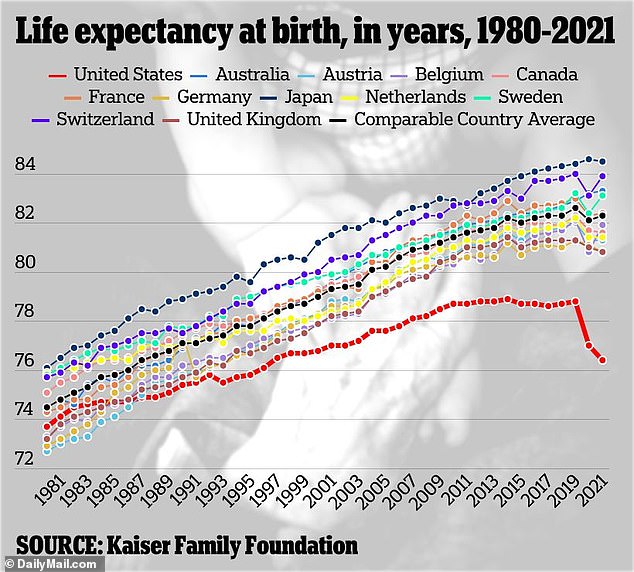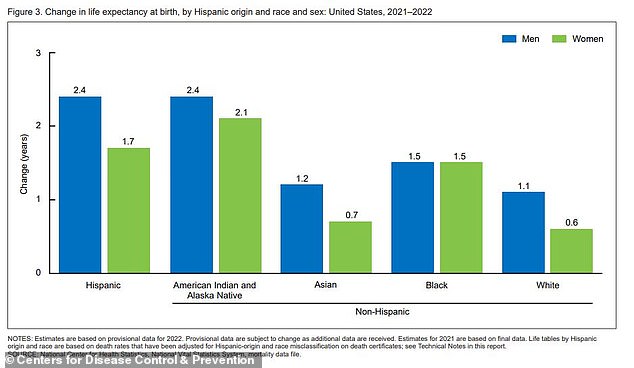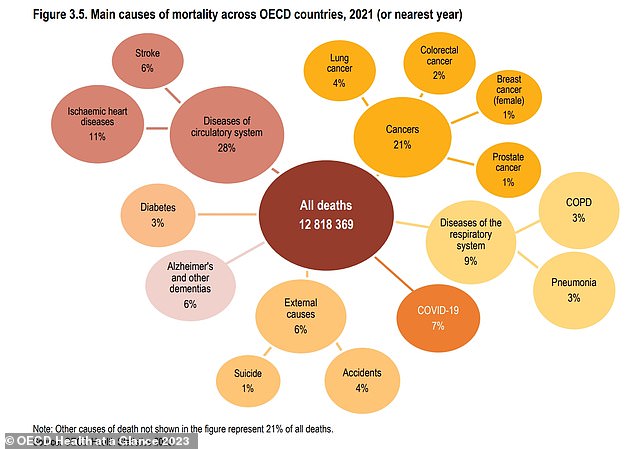CDC data shows US life expectancy crept up to 77.5 in 2022 – which is still lower than CHINA and most of the developed world
Life expectancy rose by just a year in 2022 as the US emerged from the Covid crisis – but it means Americans are still dying younger than those in most of the developed world.
A report released Wednesday by the Centers for Disease Control and Prevention (CDC) shows that life expectancy increased to 77.5 years, up from an all-time low of 76.4 years in 2021.
A boost was always expected to come as Covid deaths leveled off, but the CDC warns the US is lagging behind other countries.
Dr. Elizabeth Arias, a CDC researcher who worked on the report, said it will “take some time before we get back to 2019 levels, before the pandemic.”
A report released Wednesday by the Centers for Disease Control and Prevention (CDC) shows that life expectancy increased to 77.5 years in 2022, a year-over-year increase from a historically low 76.4 years in 2021 .

Although the US is recovering from a sharp rise in Covid deaths, the country still ranks far below other developed countries. Even taking into account the recent increase in life expectancy, countries like Japan, France and Sweden rank much higher
The agency said more than 84 percent of the jump was due to a dip in Covid deaths.
In 2021, the virus was the third leading cause of death in the country, after heart disease and cancer – which still top the list as the most common causes of death.
Rising suicides and homicides, plus a fivefold increase in overdose deaths over the past decade — fueled by a rise in fentanyl contamination — have also contributed to the decline.
According to the latest CDC data, life expectancy increased the most for non-Hispanic American Indian and Alaska Natives, from 65.6 to 67.9. The Latin American population lagged close behind, with an increase of 2.2 years from 77.8 to 80.
Life expectancy remained longer for women. In 2020, women lived six years longer than men, the largest difference since 1996. In 2022, the difference narrowed to 5.4 years, compared to 5.8 years in 2021.
“There were positive results across the board… all racial and gender groups experienced increases in life expectancy,” Dr. Arias said.

The CDC said more than 84 percent of the jump in life expectancy was due to a dip in Covid deaths

According to the latest CDC data, life expectancy increased the most for non-Hispanic American Indian and Alaska Natives, from 65.6 to 67.9. The Latin American population lagged close behind, with an increase of 2.2 years from 77.8 to 80 years.
However, the US lags behind other developed countries.
Nonprofit organization KFF compared U.S. life expectancy data from 1980 to 2021 with 11 other countries. The analysis found that while rates among the US and peers increased gradually until the Covid pandemic, the US recovered more slowly.
Between 2020 and 2021, life expectancy slowly started to increase again in countries such as Japan, Switzerland, France and Sweden.
However, CDC data shows that US life expectancy fell to 76.4 years in 2021, the lowest level since 1996. This is a decline of 2.4 years from 78.8 years in 2019, and a decline of 0.6 years compared to 2020.
“This increase does not fully offset the loss of 2.4 years of life expectancy between 2019 and 2021, which was primarily due to the increase in deaths from the COVID-19 pandemic,” the CDC report said.
In comparable countries, the average life expectancy in 2021 was 82.3 years, a decrease of 0.3 years compared to 2019 and an increase of 0.2 years compared to 2020.
A 2023 report from the Organization for Economic Co-operation and Development (OECD) compared life expectancy and a range of other health statistics in 48 developed countries for the period 2019 to 2022.

Above you see the percentages of causes of death around the world. Circulatory diseases were responsible for 28 percent of deaths worldwide, and cancer accounted for 21 percent. Covid was responsible for seven percent of deaths
With a life expectancy of 76.4 years, America ranks 34th – 15th from the bottom – and well below the OECD average of 80.3 years.
Even if the CDC’s new data were applied to the OECD rankings, the U.S. would rank 20th, right behind China.
The report attributes America’s low life expectancy to obesity, heart disease, alcohol consumption, smoking and diabetes. While previous similar reports have attributed excess deaths to fentanyl and gun violence.
The report shows that the US has fallen behind countries plagued by crime and violence, such as Colombia, which has never topped the US in OEDC reports since its inclusion in 2015.
The South American country is home to a range of criminal groups and gangs and is one of the three largest cocaine-producing countries in the world. An estimated 24,000 fighters are present in the country as part of armed groups and organized crime.
In the US, of the causes of death identified in 2021, the most people died from circulatory diseases, followed by cancer and Covid-19.
This report is not the only recent data revealing the dire situation in America.
Earlier this year it was announced that the US is among the top 10 countries with the highest death rates for certain non-communicable diseases.
Researchers from the life insurance company William Russell analyzed data on mortality rates from six common non-communicable diseases: cancer, heart disease, stroke, lung disease, liver disease and kidney disease.
America’s poor ranking was attributed to a combination of high obesity rates – which increase the risk of multiple diseases – and previously higher rates of smoking.
A second separate report from September also exposed the grim life-and-death situation in America, when it found that the US could avoid 1 million deaths a year if the country’s death rates were on par with other wealthy countries .
Researchers looked at all-cause mortality rates by population size since the 1930s in nearly two dozen comparable countries, including Britain, Canada, Japan, Australia and 17 European countries.
They found that despite the US being the richest country, it has suffered more deaths per capita than any other country since about 1980.
The study pointed to the opioid and fentanyl epidemic, gun violence and obesity-related deaths, all of which were exacerbated by the Covid pandemic, as the reason America is an outlier.
Steffie Woolhandler, senior author of the September study and professor at Hunter College’s School of Urban Public Health, also blamed the US health care system, insurers, corporate greed and politicians for the US’s preventable deaths. experienced.
Woolhandler said: “We waste hundreds of billions every year on health insurers’ profits and paperwork, while tens of millions cannot afford medical care, healthy food or a decent place to live.
“Americans die younger than their counterparts elsewhere because when corporate profits conflict with health, our politicians side with corporations,” she added.
